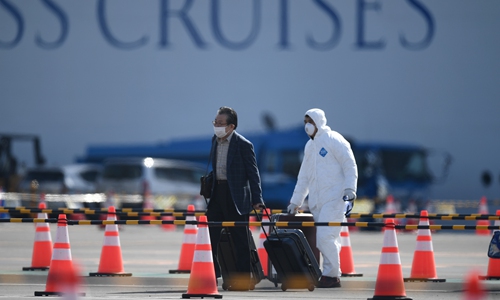Passengers wearing face masks, who were stranded on the novel coronavirus-infected Diamond Princess ship in Japan, are taking a special bus en route to a quarantine center in the New Territories in the Hong Kong Special Administrative Region (HKSAR) on Thursday. The HKSAR government has arranged chartered flights to bring back 106 Hong Kong passengers onboard the ship.
By Chen Qingqing
The way the crisis in epicenter Wuhan is being handled is expected to offer a lesson to other Asian countries as the unprecedented challenges potentially facing the region call for closer regional cooperation and enhanced information-sharing mechanisms.
While China sees the situation outside Central China’s Hubei Province stabilizing amid the outbreak of novel coronavirus pneumonia (COVID-19), neighboring countries are now facing a potentially more severe epidemic battle, as South Korea reported their first fatalities on Thursday and Japan has confirmed three deaths with the fast-spreading virus causing more infections.
While countries such as the US, the UK and New Zealand are now preparing to repatriate their nationals from Diamond Princess this week, after the outbreak in the cruise liner with over 600 confirmed cases, some experts described the situation as “chaotic,” questioning the effectiveness of infection control measures onboard.
While hundreds of passengers who had been tested negative were allowed to disembark after a 14-day quarantine from the vessel on Wednesday, Japan reported 726 infections, including those confirmed onboard, as of press time. And two passengers have died from the virus, Japan’s health authority said.
South Korea also reported its first death from the virus on Thursday and 53 new cases, bringing the total number of infections in the country to 104.
The mayor of Daegu, a South Korean city southwest of the capital Seoul, described it as an unprecedented crisis after a suspected “super-spreading” scenario occurred at a local church, leading the number of infections to spike and raising the prospect of wider transmissions, Reuters reported on Thursday.
Chinese President Xi Jinping spoke on the phone with South Korean President Moon Jae-in on Thursday. During the conversation, Xi said he believes that following the victory against the novel coronavirus disease, the friendly feelings between the Chinese and South Korean people will grow even deeper, and bilateral exchanges and cooperation more flourishing.
In addition, other countries and regions in Asia also see infection numbers climbing. Singapore had three new cases confirmed on Wednesday, raising the total number to 84.
The Hong Kong Special Administration Region (HKSAR) reported a total of 68 new cases as of Thursday while the island of Taiwan saw the number climb to 24, with one death reported.
Due to the virus’ spread, the HKSAR government also announced on Thursday it would continue special arrangements for civil servants until March 1 to minimize social contact and lower the risk of getting infected, while some black-clad protesters continued protesting against the government’s response to the disease. Shortage of medical supplies, for example, protective masks, triggered panic and fears, underscored by a recent robbery of 600 rolls of toilet paper.
Concerns over new outbreaks in Asia have been surfacing, while some countries held emergency meeting to raise alarm over the fast-unfolding disease, which would pose a threat to public health and dampen regional growth. Some observers and analysts even asked if Japan would become the second Wuhan, as the Japanese government’s early response to the disease sparked controversy.
“From the way it contained the virus spread on the cruise ship, the Japanese side had not attached great importance to the matter. The outbreak onboard has not been well contained and the way the passengers disembarked was also worrisome,” Ni Yueju, a senior research fellow at the Institute of World Economics and Politics of the Chinese Academy of Social Sciences (CASS), told the Global Times on Thursday.
If those infected passengers could not be properly quarantined for further observation in Japan, we may see new outbreaks in the country in the coming days, she said.
A Japanese medical expert also publicly criticized the mishandling of the outbreak onboard due to the mixing of the infected and clean areas, and some passengers also complained about insufficient measures in virus control and a delayed response for medical treatment. Some of those who left even went home by foot, or by taxi, triggering heated online discussions not only in Japan but also in China.
“I hope other countries won’t make the same mistakes that we have made [in Wuhan] as we paid a heavy price,” a Chinese netizen said on Chinese Twitter-like Weibo on Thursday.
Why did hundreds of people from the cruise ship return home on their own, even by bus? If some have been diagnosed onboard, those people freed from the ship should be put in another 14-day quarantine, another netizen said. “Does Japan understand the lesson from Wuhan?”

A lesson to learn
Faced with a possible large-scale spread of the epidemic, governments in countries in the region were urged to adjust their policies by coming up with stricter control measures, a faster response mechanism and better preparations. Some analysts suggested that the lessons learned from Wuhan’s mishandling of the matter at the early stage could become a reference for policymakers in other countries.
“The first thing Japan needs to do now is to cut off the infected sources, then improve its testing capability, as some suspected patients without symptoms also need to receive medical treatment,” Lu Hao, a research fellow at the Institute of Japanese Studies at the CASS, told the Global Times on Thursday.
Bringing all confirmed cases to medical treatment, putting all suspected and close contacts into quarantine and enhancing the test capability have been part of major policies China has implemented in the battle against the epidemic, which authorities described as “unprecedented challenges” since the founding of the People’s Republic of China. Meanwhile, countries in the region should consider the economic impact of the epidemic and come up with relevant policies to stop the virus’ ripple effects. “That’s what we do now, which is also the major issue the Japanese need to think of,” Lu said.
Japan also faces the same problems China encountered in recent weeks. For example, the shortage of nucleic acid test kits hindered hospitals in Japan to screen as many suspected patients as possible. Local authorities also began to urge the public to wear protective masks in recent days.
China donated a batch of test kits to Japan recently as the virus has no border and all the countries should stand together to fight it, according to the Chinese Embassy in Japan on Thursday.
Economic woes
While industries in Asian countries are highly integrated, the ongoing epidemic is casting a shadow over regional growth but still offering a new chance to bring the countries in the region closer in fighting the battle for common interests, analysts said.
“The economic shockwaves from the COVID-19 epidemic to the rest of East Asia are also expected to be significant in the first quarter of 2020,” Rajiv Biswas, chief economist on the Asia-Pacific region at IHS Markit, told the Global Times on Thursday.
The virus impact is seen in the collapse of Chinese tourism to many Asian economies as well as the expected weakness in the Chinese manufacturing sector, as new orders in the first three months are expected to drop due to the protracted closure of Chinese industries in February, he noted.
“For many East Asian economies, China is also a key export market for manufacturers and raw materials, so weaker Chinese factory orders will hurt their export sectors in the near-term,” he added.
Still, the ongoing battle against the little-known disease is offering the chance to enhance the information-sharing mechanism among Asian countries, with a hope to improve the emergency-responding mechanism and local governance.
“This epidemic makes more people realize that China, Japan and South Korea indeed share a common destiny: they support each other in difficult times, coexist, face similar problems,” Lu said. “How to make the relationship more sustainable is something that deserves deeper reflection.”



